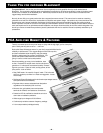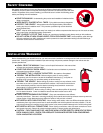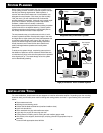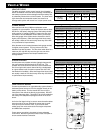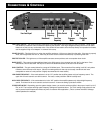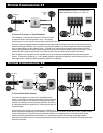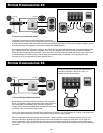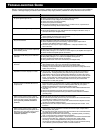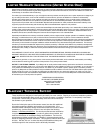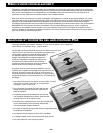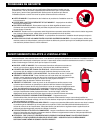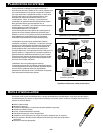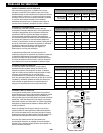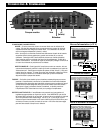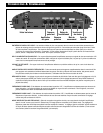
SYMPTOM
No power (power light not on)
Power but no sound (power light is on)
No sound from one channel or entire side
Very low sound level
Power amplifier turns on and off repeatedly
(motor-boating sound)
Amplifier turns off during loud or distorted
passages
Amplifier performs fine but gets very hot to
the touch
Amplifier turn-on/turn-off pops or noises
Cracking noises on AM/FM radio but not
on tape or cd.
Whining noise, engine running, varies in
pitch or loudness with engine speed, AND
varies with radio volume control setting
(this is generally a RADIO installation
problem)
Whining noise, engine running, varies in
pitch or loudness with engine speed, BUT,
DOES NOT vary with radio volume control
setting (this is generally an amplifier
installation problem)
PROBABLE CAUSE OR CORRECTION
■
Check connections to amps +12 volt, ground, and remote lines.
■
Use voltmeter to verify voltages are at terminals of amp.
■
Check main power connection at battery.
■
Check fuse in power line at battery.
■
Disconnect all speakers but not power lines - if unit then turns on, a speaker short
or speaker line touching vehicle chassis is likely.
■
Check all input cable lines for connection.
■
Disconnect speakers from amp, test speaker lines with digital voltmeter to verify >2
ohms per channel (non-bridged mode).
■
Check radio’s balance and fader control positions - verify they are at center.
■
Check speaker connections at amp and speaker.
■
Check input leads for connection to amp.
■
Verify radio balance and fader controls are at center positions.
■
Check amplifier’s input gain control setting - adjust for higher output levels if
necessary (gain settings closer to 0.3 volts).
■
Receiver may have very low output voltage levels - a step up “line driver” may
have to be used.
■
Make sure power connections at batter are tight.
■
Verify battery voltage is >11.5 volts DC (12.5-15V engine on) at amplifier with engine off.
■
Check all radio and amplifier ground connections.
■
Input stage being over-driven - lower input gain (closer to 4 volt setting).
■
Verify battery voltage is >11.5 volts DC at amplifier with engine off.
■
Check all radio and amplifier ground connections.
■
Verify speaker loads >2 ohms on all channels (non-bridged mode).
■
Input gain control too high - lower accordingly (closer to 4.0 volt setting).
■
Verify speaker loads >2 ohms on all channels (non-bridged mode).
■
Verify the mounting location allows for free air movement around the amp.
Preferably, the amp should be mounted with fins up and down so rising heat moves
quickly away from amp.
■
“turn on race” - disconnect trigger from radio and turn on/off via a wire jumper to
power terminal. If noise goes away, the radio is turning on/off too slowly. This is
radio problem and can only be corrected with outboard turn-on delay relay system.
■
Radio “thump” - disconnect the RCA input lines to the amp and turn on/off via radio
trigger. If noise goes away without RCA lines connected, the radio is sending pops
out through RCA lines. This is a radio problem and can only be corrected with
outboard turn-on delay relay system.
■
Ensure the problem is “radiated noise” by placing a portable FM radio near the car
engine. If noise is picked up, then it is a vehicle problem and not your system.
Research to isolate the source and properly shield or bypass.
■
Are spark plugs and wires > 3 years old? These can often radiate substantial noise
when old.
■
Verify the engine block has a good ground connection to chassis ground.
■
Verify the engine compartment hood is grounded to vehicle chassis via a braided
grounding strap.
■
Verify all power and ground connections are clean at radio.
■
Re-route radio power and ground so they are sourced from same connections back
at amplifier (this is called a “common” ground).
■
Check all ground connections to ensure clean surfaces that have all paint removed
and also not oxidation buildup over time.
■
Verify there is some kind of power filtering choke assembly at back of radio. If not,
install one.
■
Check battery ground connections at chassis are clean and tight, scraped free of
oxidation, paint, and grease.
■
Re-route radio power and ground so they are sourced from same connections back
at amplifier (this is called a “common” ground).
■
Bypass all equipment between radio and amp (e.g., equalizers) directly connecting
radio. If noise goes away, signal processor has problem.
■
Check for signal level “ground loops” - disconnect the outer shield of the RCA cable
at one end of the cable (e.g., radio end). If noise goes away, modify cables
accordingly. There are voltage differences at the ground connections of the
components and these are NOT correctable any other way than such shield cutting
or an outboard “ground loop isolator” which is a small transformer.
TROUBLE-SHOOTING
GUIDE
– 10 –
Below is a basic trouble-shooting guide to assist in seeking out and correcting a problem that may occur in the installation
process. Although lengthy, this chart cannot address every single problem possible but mainly the ones most common.



